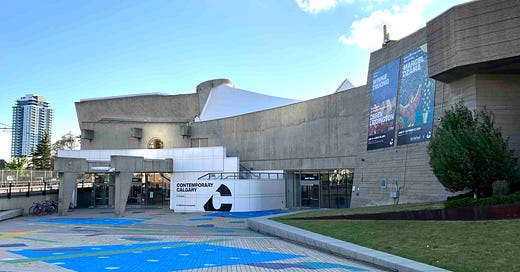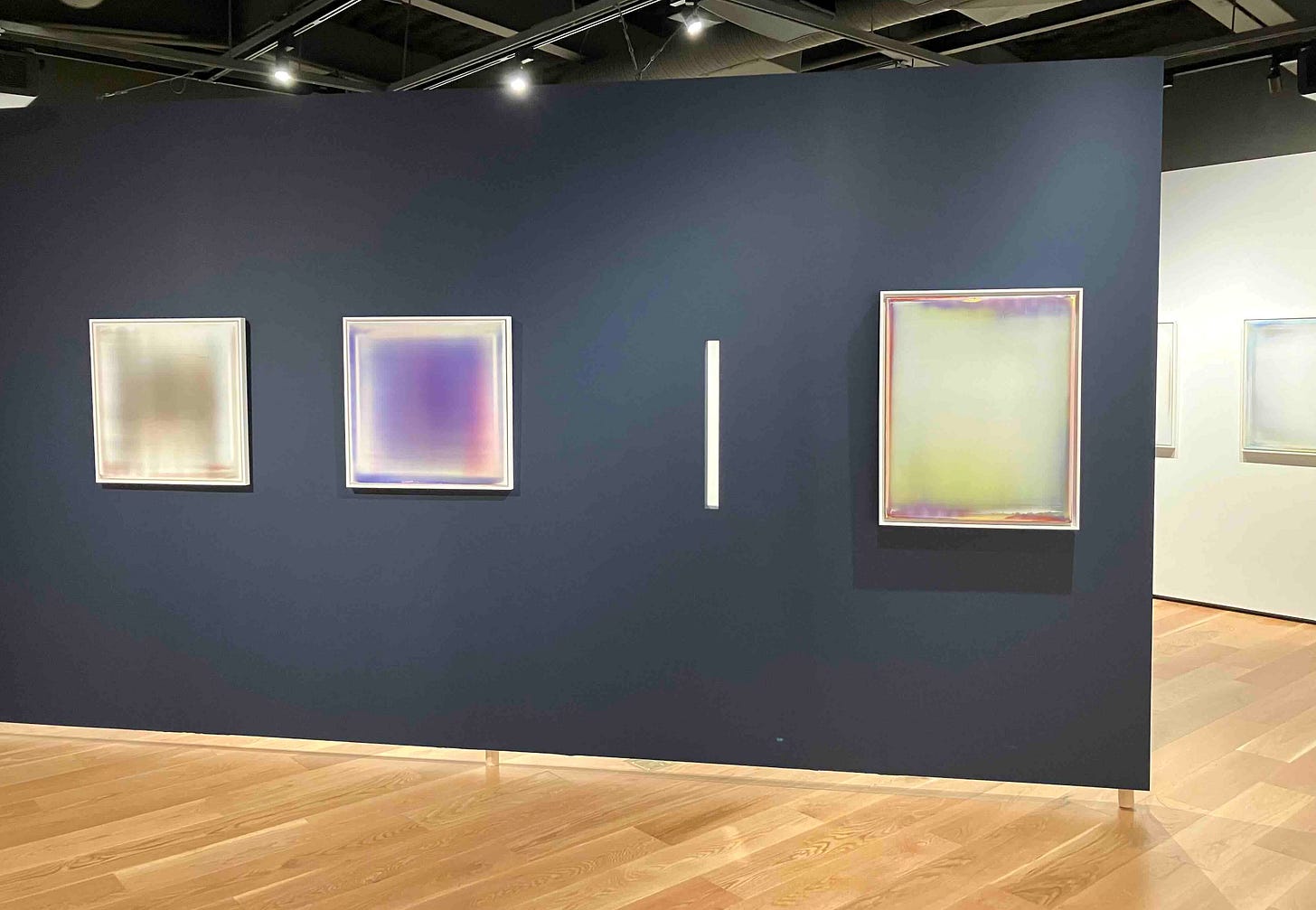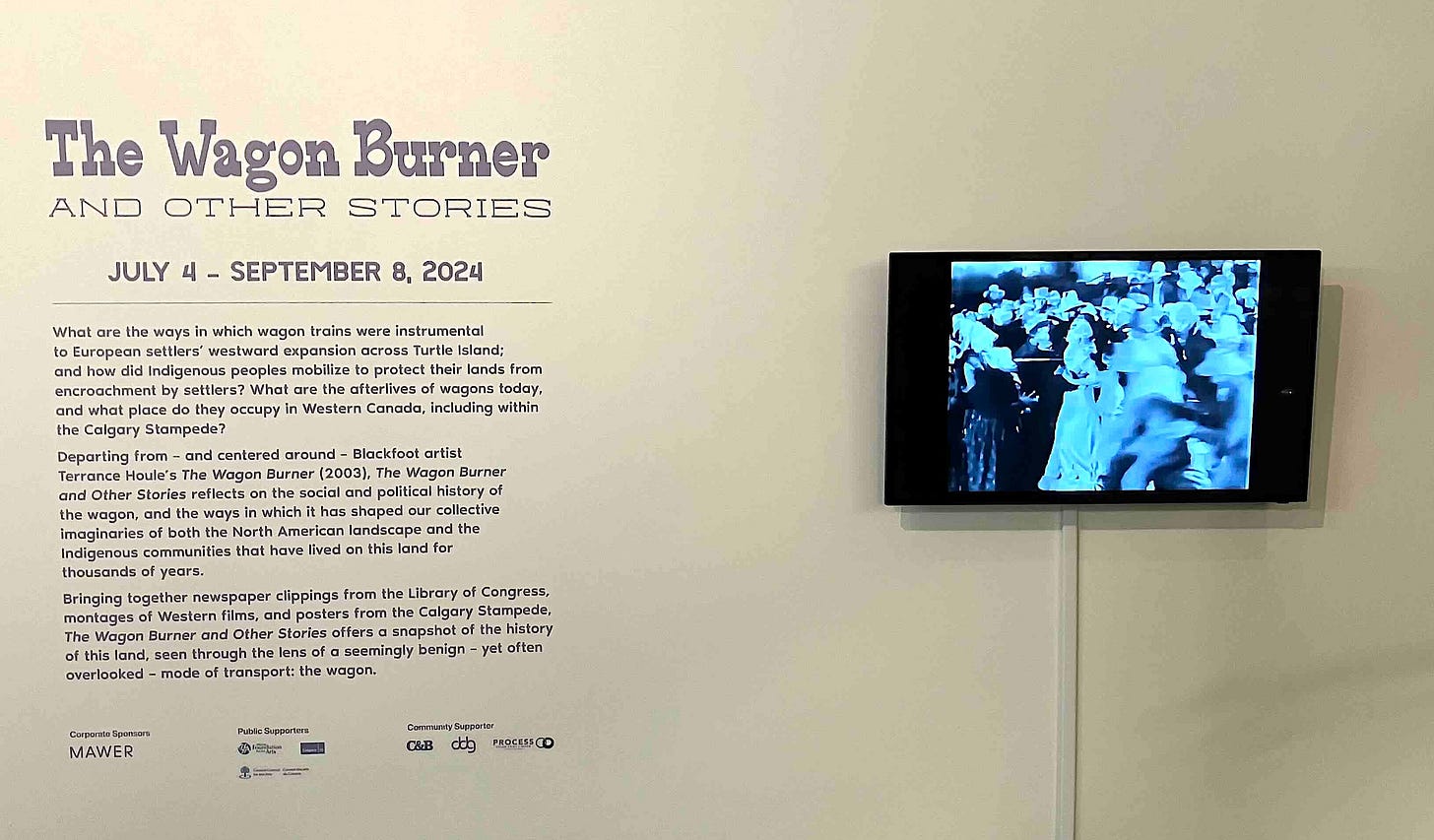Contemporary Calgary
With Exhibitions by Marie Lannoo, Marcel Dzama, Terence Houle, Winnie Truong, and Derek Liddington
This post is part of a series on contemporary art venues and exhibitions that I come across in my travels.
Calgary has long needed a permanent exhibition space dedicated to contemporary art. Contemporary Calgary, Calgary’s newest museum, opened in the middle of the COVID pandemic and has since played host to some of the most exciting art exhibitions and events in this city.
For years, Calgary seemed to struggle to establish a single, world-class, contemporary art venue and not for lack of trying. Calgary actually had, and still has, a very robust visual arts community. The city is home to one of Canada’s four dedicated art colleges, Alberta University of the Arts, as well as the University of Calgary with its visual art and art history programs. The Glenbow Museum has collected and exhibited art since 1966 but has always been better known for its historical artifacts than its art. Still, in the late 1970s and through the 1980s, there were plenty of smaller spaces to exhibit contemporary art including the Triangle Gallery at the city hall, the Muttart Public Arts Gallery on the second floor of the public library, the Nickle Galleries at the University of Calgary, and the Illingworth Kerr Gallery at the University of the Arts. Calgary is also home to one of the first artist-run centres in Canada, the New Gallery, founded in 1975. Two more artist-run centres followed: TRUCK Contemporary Art in 1983 and Stride Gallery in 1985. They are all still in operation. Calgary has also had an active commercial sector with TrépanierBaer, Paul Kuhn, Newzones, and Herringer Kiss galleries all featuring contemporary art. Throughout the 1980s, the Alberta oil industry also contributed to the artistic vibrancy of the city by collecting and exhibiting contemporary art. Both Gulf and Petro Canada featured contemporary art in small galleries housed in their office towers. All of these venues focused on local, regional, and national artists.
In the decades since 2000, several attempts were made to re-brand and amalgamate the presentation of contemporary art in Calgary. The Muttart Gallery changed its name to the Art Gallery of Calgary and moved downtown to 8th Avenue while the Triangle Gallery, with veteran curator and art writer Jeffrey Spalding at its helm, rebranded itself as the Museum of Contemporary Art Calgary (MOCA). In 2018, these two institutions joined together with the Institute of Modern and Contemporary Art to form Contemporary Calgary. The new organization then campaigned for a single location, one that could easily accommodate large international exhibitions as well as local, regional, and national art. In 2018, the group made an agreement with the City to lease the former Centennial Planetarium in the western reaches of the downtown core. Built in 1967, the building was retrofitted in 2019 to accommodate art exhibitions, and then opened in the midst of the pandemic with an exhibition of work by Yoko Ono.
The Centennial Planetarium, despite its late-modern brutalist architecture, suits its new purpose well. On the outside the arrangement of textures and forms along with the colourful entrance plaza make the building a visual landmark at the edge of the downtown. Inside there is an eclectic mix of exhibition spaces over three levels, a huge open central atrium with a spiral ramp leading to the lower level, and two theatres. During my visit at the beginning of July, I was delighted to see five exhibitions.
In the Observatory Gallery on the Third Level, I found an exhibition of paintings by Marie Lannoo and curated by Wayne Baerwaldt. Lannoo is one of those Canadian female artists we have not heard enough about. She has been quietly practicing in Saskatoon for years. I have known Lannoo for over 20 years and watched her progress as she has delved deeper and deeper into the physics of light and colour. Her curiosity is endless and her reading and research extensive. Each iteration of her oeuvre is like a new experiment where she translates her learning into visually stunning paintings and installations.
In Extremis is a suite of paintings on canvas that Lannoo created during the pandemic lockdown, a time she found most productive. With few other distractions, she spent her time in the studio and began applying, with a squeegee, thin layers of translucent colour on square canvases. The result is this series of vibrant paintings with near-opaque centres that shimmer with auras of colour.
Since exhibitions were curtailed during the pandemic, Lannoo partnered with Wayne Baerwaldt to produce an exhibition of the new work in book form. The book, In Extremis, was launched in November 2023 at the Remai Modern in Saskatoon. The culminating act of this collaboration is the Contemporary Calgary exhibition. In the square space of the Observatory Gallery, Lannoo and Baerwaldt have made the visual experience of the work paramount. The space is bisected by a dark blue diagonal wall which stands out sharply against the lighter, subtler hues of the surrounding walls. The paintings are then hung against the background best-suited to reflect and activate their colours. No identifying labels interrupt this presentation. Instead, the viewer is invited to immerse herself in the subtle nuances of the light and colour radiating from each work.
Another delight was to see Ghosts of Canoe Lake: New Work by Marcel Dzama. Originally from Winnipeg, Dzama lives and works in New York where he has enjoyed a successful international career. This is his first major Canadian exhibition in ten years and a joint venture with the McMichael Canadian Art Collection in Ontario. Dzama’s works on paper and several films were displayed in the Ring Gallery, a wide annular hallway around the Dome Theatre. Dzama’s film, To Live on the Moon (For Lorca), commissioned for and featured at the Performa Biennale in New York in 2023, was on view in the Dome Theatre.
Dzama’s works on paper are like children’s book illustrations – colourful and full of wild imaginings, and inhabited by strange recurring characters. Surrounded by painterly patterning, grinning cats, dancers in polka dot costumes, skeletons, and a sinister smiling moon-face appear over and over again. Dzama’s films, which are mostly black and white, are equally strange; like entering a bizarre, surrealist dream. There is never a clear narrative and masked, costumed characters appear and disappear. The titles of the works give some clues as to the subject. Ghosts of Canoe Lake, for example, refers to the revered Canadian painter, Tom Thomson, who mysteriously drowned in Canoe Lake in 1917. Dzama’s paintings hint at this subject by including a recurring image of a canoe and scenes of a forest and lake painted in Thomson’s familiar style. The film, To Live on the Moon (For Lorca), is Dzama’s rendering of Federico Garciá Lorca’s 1929 surrealist screenplay, Trip to the Moon. It is an imagined retelling of Lorca’s birth, execution, and resurrection on the moon. Even if one does not recognized these subjects, the odd images that play throughout Dzama’s work seem to capture our current climate of senseless war and absurd politics.
Dark humour with a sharp political edge is the highlight of The Wagon Burner and Other Stories featured in the second, smaller theatre. In this short film from 2003, Blackfoot artist, Terence Houle, depicts a young Indigenous man as he lights a model of a covered wagon on fire and stomps on it. This is a delicious metaphor for the pent-up emotions and anger that Indigenous people have endured since European settlers began heading West across North America in their covered wagons. The film has been exhibited at numerous venues and won several awards. Its reappearance at Contemporary Calgary is timely; the annual Calgary Stampede, a celebration of cowboys and the West, opened the day after the premiere of Houle’s exhibition.
The Flanagan Family Gallery, a box-like addition to the original building – featured two exhibitions, Winnie Truong: Curious Nature and Derek Liddington: the trees weep, the mountain still, the bodies rust. Both exhibitions explore our perceptions of nature. Truong is a Toronto artist who uses cut and shaped paper to represent whimsical, imagined tableaux of plants and the female body in a fecund and beautifully rendered depiction of nature. The work is presented as murals, as stand-alone sculptural pieces, in box frames, and in stop-motion animation. The impression is of an ever-transforming nature that is, like the female body, a rich source of renewal and reproduction.
Derek Liddington is another Toronto artist. His exhibition considers how nature is the source of our mythical fantasies of elves, ogres, and giants. Nature, in Liddington’s work, is life itself, bursting with regeneration but also death and decay. Things emerge from the ground but also go back into the ground. For this exhibition, Liddington has literally painted the walls and placed paintings on the floor, creating a space that envelops the viewer in the colours and mysteries of nature.
In a city that has supported contemporary art in smaller venues for decades, Contemporary Calgary is finally providing a large dynamic space to host exciting, world-class exhibitions and events. With continued support from government, donors, and members, Contemporary Calgary has the potential to make Calgary — a city better known for rodeos and oil — a go-to destination in Western Canada for contemporary art.
If you are in Calgary be sure to drop by Contemporary Calgary. Marie Lannoo: In Extremis continues until October 13, Ghosts of Canoe Lake: New Work by Marcel Dzama until October 27, Terence Houle’s The Wagon Burner and Other Stories until September 8, and Winnie Truong: Curious Nature and Derek Liddington, the trees weep, the mountains still, the bodies rust until August 25.












I have been to the ‘Planetarium’ several times in the 70s and 80s and am thrilled to hear that it is a contemporary art space now! I really enjoyed reading about Marie Lanoo’s work. Thank you so much for sharing.
My high school had its graduating Art Exhibition at The Glenbow in 1978 so of course I have always felt Calgary was artsy but under recognized.
Thanks Marie Leduc for this thoughtful and informative article and for your support of my work.